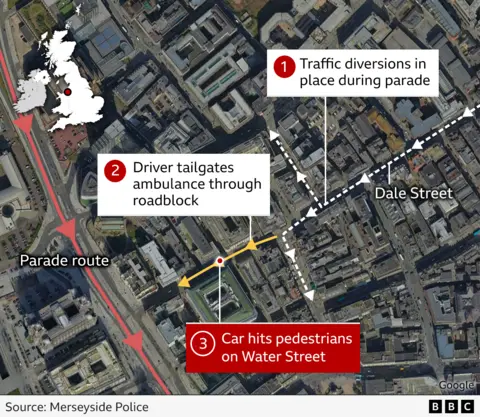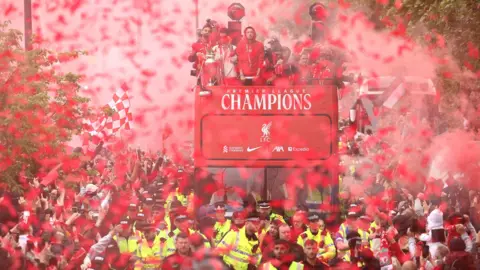Liverpool parade traffic decisions criticised
 PA Media
PA MediaAlmost a week after a car drove into crowds at Liverpool FC's victory parade, questions are being asked why a city centre road remained open to vehicles.
Despite warnings given to businesses over expected crowds, Dale Street, which runs through the city centre, was not closed.
At about 18:00 BST on Monday, 79 people were injured when a car crashed into fans on adjoining Water Street during the trophy parade.
But the council insists that several months of planning went into organising the event, and that a "robust traffic management plan" was agreed by all partners.

Gareth Morgan, 46, who owns The Dead Crafty Beer Company on Dale Street, says he was told to remove street furniture due to the number of people expected, yet "the council still let vehicles up and down".
"When you have 800,000 people walking back up to the city centre, it's crazy that any of the main roads in the city centre were open," Mr Morgan said.
"Everyone I have spoken to is in agreement that it should not have been open to traffic.
"The pavements aren't big enough to take that volume of the public, so the only place for them to go is the road."
Mohamad Abbar, who works at A2Z Mobile on Dale Street, echoed his comments. "There were too many people on this road," he said, adding he thought it was "supposed to be closed".
But a Liverpool City Council spokesman said Dale Street had never been completely closed for a Liverpool FC victory parade in the past, and the bus had travelled on the same route as in 2019 and 2022.
The spokesman added that the part of Dale Street which remained open was a key route for traffic going to and from the Mersey Tunnel.
Tom Benson, 24, who works in Manchester, said he had travelled to Liverpool for various events in the past, when he felt a lot more roads had been closed.
"This time around that wasn't the case," he said.
"It seemed like a fair few of the roads were opened despite there being significantly more people."
Mr Benson also said he felt organisation at Liverpool's main Lime Street Station was "pretty terrible" after the parade, as fans tried to make their way home, with police blocking all entrances and "thousands of people" queueing for hours only to be told to "go and join a queue at the other side of the station".
 EPA
EPAAnother 24-year-old, who asked not to be named, said he queued for more than an hour at the train station only to be told he was in the wrong place. He described the scenes there as "absolute carnage" and feared a potential safety or security risk.
"There was no organisation at all," he added. "We were pretty lucky we got the last train to Birmingham, but it was terrible for the people with children who were all crying."
Network Rail said there had been "an unprecedented number of people travelling to and from Lime Street Station to be part of the parade."
The firm used "tried and tested plans" to manage demand, it said, including closing the Lime Street entrance and putting a one-way queueing system in place starting at another entrance on the Skelhorne Street.
However, the large numbers of people wanting to travel at the same time "significantly impacted" the queuing system, and Network Rail said it was reviewing what happened.
"We are sorry that people were delayed in getting to where they needed to be during a distressing time," a spokesperson said.
On Friday, former Royal Marine Paul Doyle appeared at Liverpool Magistrates' Court and Liverpool Crown Court where he faced seven charges including wounding with intent, causing grievous bodily harm (GBH) with intent, attempting to cause GBH with intent and dangerous driving.
Mr Doyle faces charges relating to six victims, including two children aged 11 and 17, after a total of 79 people were injured.
He will next appear at Liverpool Crown Court on 14 August for a plea hearing.
Listen to the best of BBC Radio Merseyside on Sounds and follow BBC Merseyside on Facebook, X, and Instagram. You can also send story ideas via Whatsapp to 0808 100 2230.
